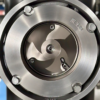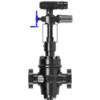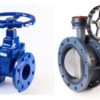You can contact us 24/7 +1(239) 355-5809
Troubleshooting and actuated ball valve and butterfly valve maintenance are crucial for peak performance, to prevent downtime, and to extend equipment life. These valves are critical equipment in industry that requires ongoing maintenance. This is a comprehensive guide that will walk you through the optimal maintenance methods and troubleshooting practices, as well as highlight the key differences between ball and butterfly valves.
Ball Valves and Butterfly Valves: The Basics
Before diving into maintenance, it’s important to understand the fundamental differences between these valves:
Ball Valves
- Working Mechanism: Possess a spherical disc (ball) with a bore in the center
- Operation: Quarter-turn operation (90° rotation)
- Flow Characteristics: Offer minimal flow resistance when fully open
- Sealing: Generally offer bubble-tight shut-off
- Pressure Ratings: Typically deal with higher pressure applications
- Space Requirements: Lower for small sizes but higher in large diameters
Butterfly Valves
- Working Mechanism: Employ a disc fitted on a turning rod
- Operation: Quarter-turn operation (90° rotation)
- Flow Characteristics: Disc is in flow path even when open
- Sealing: Good but not normally as tight as ball valves
- Pressure Ratings: Typically applied to lower pressure services
- Space Requirements: Always space-saving in all sizes
Preventive Maintenance of Actuated Valves
Routine Maintenance Procedures for Both Classes of Valves
- Routine Visual Inspection
- Inspect for outer leakages at body joints and stems
- Inspect for corrosion, coating damage, or other easily seen deterioration
- Check actuator mounting hardware for safety
- Actuator Maintenance
- Provide proper electrical connections and insulation (in electric actuators)
- Verify quality of air supply and pressure settings (for pneumatic actuators)
- Check solenoids, limit switches, and position indicators
- Lubricate moving parts according to manufacturer instructions
- Cycling the Valve
- Periodically turn valves that are in the same position for long durations
- Perform full-stroke tests to verify proper operation
- Measure cycle times and compare to baseline values
- Documentation
- Keep proper records of all maintenance operations
- Take baseline performance measurements to compare
- Have valve and actuator manuals available
Ball Valve-Specific Maintenance
- Seat and Seal Inspection
- Inspect for damage or wear on the ball surface
- Check valve seats for compression set or damage
- Check stem packing integrity
- Lubrication
- Apply correct lubricant to stem components
- Confirm lubricant compatibility with process media
- Prevent over-lubrication that might contaminate the process
- Ball Movement Evaluation
- Verify smooth, even ball movement
- Hear unusual sounds during usage
- Search for correct alignment of seat and balls
Butterfly Valve-Specific Maintenance
- Disc and Seat Test
- Inspect disc edges for damage or wear
- Inspect elastomer seats for chemical attack, hardening, or deterioration
- Check disc-to-seat alignment
- Shaft and Bearing Maintenance
- Inspect shaft seals for any leaks
- Inspect shaft-to-disc fastening for security
- Inspect bearings for free rotation
- Body Cavity Assessment
- Look for buildup or accumulation of debris
- Inspect for evidences of erosion, especially downstream of the disc
- Inspect drain plugs (if equipped) are operational
Troubleshooting Common Issues
Actuator-Related Issues Affecting Both Valve Types
- Valve Will Not Work
- Likely Causes: Power/air loss, solenoid failure, mechanical binding
- Solutions: Check power/air supply, solenoid operation, check for blockages
- Erratic Operation
- Cause of Occurrence: Signal problems, defective parts, lack of air/power
- Solutions: Check signal integrity, inspect internal components, verify supply sufficiency
- Slow Operation
- Possible Causes: Supply pressure problems, actuator sizing, internal restrictions
- Solutions: Reduce supply pressure, check actuator sizing, check for blockages
Ball Valve-Specific Problems
- Leakage Through Closed Valve
- Likely Causes: Seat damage, foreign material between seat and ball, damage to ball surface
- Solutions: Clean seats, replace seats if broken, check ball for scoring
- Challenging Manual Handling
- Possible Causes: Stem damage, dry bearings, process buildup
- Solutions: Lubricate stem components, wash internal components, look for misalignment
- External Leakage
- Probable Causes: Body bolting loose, damaged body gasket, stem packing failure
- Repairs: Tighten body bolts to specifications, replace gaskets, adjust or replace packing
Butterfly Valve-Specific Issues
- Incomplete Closure
- Possible Causes: Actuator limit switch drift, disc-seat misalignment, blockage
- Solutions: Realignment of disc and seat, recalibration of limit switches, foreign body inspection
- Excessive Torque Requirements
- Likely Causes: Shaft damage, disc-seat interference, bearing issues
- Solutions: Grease bearings, check shaft integrity, check disc-seat clearance
- Vibration During Operation
- Probable Causes: Turbulence de flujo, objetos sueltos, instalación incorrecta
- Solutions: Check installation site, tighten all fasteners, check flow control devices
Maintenance Frequency Guidelines
Critical Service Valves
- Visual inspection: Monthly
- Full operating testing: Quarterly
- Full maintenance: Yearly or bi-yearly
Standard Service Valves
- Visual inspection: Quarterly
- Complete operational testing: Bi-annually
- Full maintenance: 1-2 years
Infrequently Used Valves
- Visual inspection: Quarterly
- Full operational testing: Semi-annually (minimum)
- Comprehensive maintenance: Every 2-3 years
Choosing Between Ball Valves and Butterfly Valves for Your Application
When replacing valves or designing new systems, consider these factors:
When Ball Valves Are Preferred:
- High-pressure applications requiring bubble-tight shutoff
- Services with particulate matter in the media
- Applications requiring minimal pressure drop
- Situations where space constraints apply only to smaller valve sizes
- Critical isolation requirements
When Butterfly Valves Are Preferred:
- Large diameter applications where ball valves would be prohibitively expensive
- Weight-sensitive installations
- Limited space between flanges
- Moderate pressure applications
- Systems requiring cost-effective solutions for larger sizes
- Applications where some pressure drop is acceptable
Conclusion
Proper maintenance and troubleshooting of actuated ball valves and butterfly valves are essential for ensuring reliable system operation. Understanding the differences between these valve types helps in selecting the right valve for specific applications and implementing appropriate maintenance programs.
Regular inspection, testing, and preventive maintenance significantly extend valve life and reduce costly downtime. By following the guidelines outlined in this article, you can optimize the performance of your valve systems and minimize operational disruptions.
Whether you choose ball valves for their excellent sealing capabilities or butterfly valves for their space efficiency and cost-effectiveness in larger sizes, implementing a structured maintenance program is the key to maximizing return on investment and ensuring long-term reliability.
Recent Posts
- Ball Valve vs. Gate Valve: Understanding the Differences
- Actuated Ball Valves and Butterfly Valves Troubleshooting and Maintenance
- What Is a Cameron Type FLS Hydraulic Gate Valve and Why It’s Important for Frac Operations
- Why the BV89OEP-45 2-Way Butterfly Valve is Most Suitable for Industrial Application






